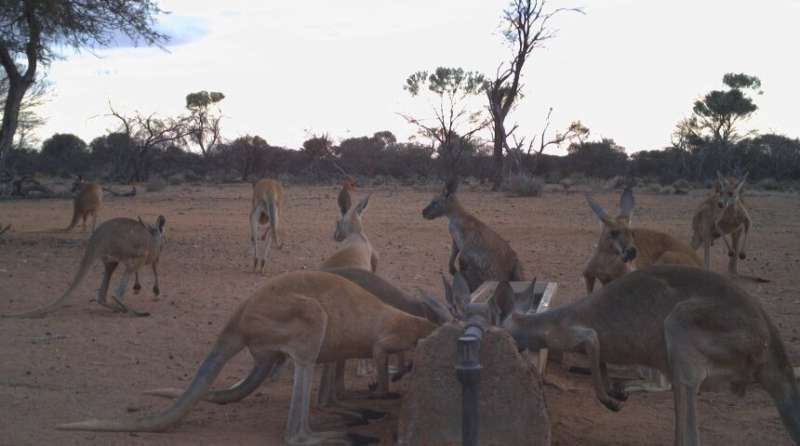Why are kangaroo populations increasing in Western Australia?

One of Australia's largest-scale animal studies has revealed how using land for agriculture and livestock, with associated water troughs and dingo control, have benefitted kangaroos in Western Australia.
The study, published in Integrative Zoology, examined 22 years of aerial surveys of kangaroos across the southern rangelands of Western Australia to understand how populations have changed, and the reasons behind those changes.
"Rangelands worldwide have been subject to major change, from widespread predator control, to the introduction of permanent livestock water sources and altered vegetation to improve grazing," said Dr. Stuart Dawson, lead author of the research at Murdoch's Harry Butler Institute.
"In Australia, these changes have essentially removed important limitations to the growth of kangaroo populations, that are really now only food limited, and that's seen kangaroo numbers grow dramatically.
"While kangaroos are obviously a natural part of most systems throughout Western Australia, when native grazers are combined with livestock, sheep and cattle, and feral herbivores, the total grazing pressure is unsustainable. In many places, there are too many mouths to feed for the fragile landscape."
The study, led by Murdoch University, with the Western Australian Departments of Biodiversity, Conservation and Attractions (DBCA) and Primary Industries and Regional Development (DPIRD), analyzed data to determine how the abundance of kangaroos has responded to environmental and management factors, the presence of the state barrier fence, and the control of dingoes for the protection of livestock.
Red kangaroos were abundant in flat, open vegetation, on pastoral land where area permitted for dingo control was high, with a jump in populations twelve months after rains.
Western gray kangaroos were most abundant on flat, agricultural land, but less abundant in pastoral areas with high permitted dingo control. Euros were most abundant in rugged pastoral land with open vegetation, where permitted dingo control was high.
"While environmental factors are key drivers of food availability and kangaroo populations, anthropogenic factors such as land use and dingo control are strongly associated with kangaroo populations," said Professor Fleming, senior author of the study.
"The widespread changes of natural landscapes into food producing regions throughout agricultural and pastoral regions in Australia has benefitted kangaroo populations too.
"This should provide land managers and regulators with pause for thought, because the long-term degradation of rangelands due to overgrazing presents a significant threat to biodiversity, and the viability of pastoral enterprises."
"Unfortunately, kangaroo management is a wicked problem" laments Dr. Dawson, "they are a natural part of the landscape, but not in such numbers, especially when combined with livestock."
"Providing water and dingo control to support livestock industries and food production has given rise to these abundant kangaroo populations, to the unfortunate detriment of pastoral industries.
"We have no easy way to control kangaroo populations. Harvesting does not keep their numbers in check people don't eat enough of it to make a dent in the population sizes. There are very few tools available to land managers and regulators.
"We implore researchers and land managers continue to build on our understanding of long-term landscape-level change in Australian ecosystems to help inform grazing management and conservation practices."
More information: Stuart J. DAWSON et al, Land use and dingo baiting are correlated with the density of kangaroos in rangeland systems, Integrative Zoology (2022). DOI: 10.1111/1749-4877.12683
Provided by Murdoch University

















